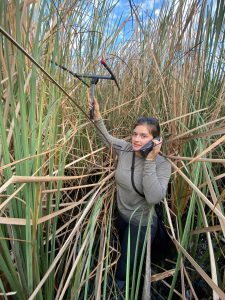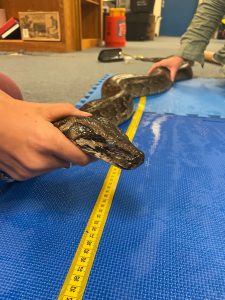-

Melissa Miller, project lead and research assistant scientist specializing in invasion biology at UF/IFAS Fort Lauderdale Research and Education Center, takes measurements and records data from one of the tracked Burmese pythons. Photos courtesy UF//IFAS Croc Docs The University of Florida has partnered with several federal and state agencies on a large-scale python removal project to protect the Everglades.
- The project combines Burmese python ecology with removal efforts to maximize opportunities to expand knowledge of their biology and habitat use and estimate their abundance and ultimately reduce the population in the Everglades.
- Researchers hope these efforts will allow for targeted removals and assessments of python control efforts, which can increase the effectiveness of python removal efforts.
University of Florida wildlife scientists are scouting for Burmese pythons in the Everglades by using previously captured pythons to lure, locate and learn how the invasive species is thriving in the Everglades.
This latest effort is a large-scale python removal scout program led by UF/IFAS scientists in collaboration with the United States Geological Survey (USGS), Fort Collins Science Center, South Florida Water Management District (SFWMD) and the Florida Fish and Wildlife Conservation Commission (FWC). Researchers are using pythons captured by SFWMD’s Python Elimination Program and FWC’s Python Action Team Removing Invasive Constrictors (PATRIC) to study python biology further as they leverage radio telemetry technology during the species mating and breeding seasons to remove pythons.
“Our study links python ecology with removal efforts,” said Melissa Miller, project lead and research assistant scientist specializing in invasion biology at UF/IFAS Fort Lauderdale Research and Education Center. “This allows for long-term, in-depth research projects, which are critical to understanding cryptic, long-lived species such Burmese pythons, all while continuing to find and remove pythons from the Everglades.”
Adult male and female pythons, provided by the water management district’s Python Elimination Program and FWC’s Python Action Team, are implanted with tracking devices and released into Everglades Francis S. Taylor Wildlife Management Area.
As pythons form mating aggregations consisting of multiple male suitors lured by a female, tracking them during their breeding season can increase the number of snakes removed. The tracked males can help scientists locate female pythons capable of producing up to 100 eggs, which can be captured and removed. Sex pheromones secreted by tracked females lure males naturally and female pythons can provide important life history information concerning reproduction and survivorship that can be used to help estimate the number of pythons in the Everglades.
The tracking devices will lead researchers to the snakes, allowing them to record behavior and document reproductive data such as nesting sites, clutch size, hatchlings and how many survive.

The project will help inform management efforts by increasing our understanding of how pythons use a predominant habitat type — sawgrass marsh interspersed with tree islands –

– within the Everglades.
The team has started tracking eight adult pythons, which will provide data on habitat use and python abundance that will help natural resource managers evaluate control efforts, said Miller, who is also affiliated with the UF/IFAS Croc Docs.
“As administering a python radiotelemetry project in the Everglades requires many resources, the project will also assess innovative tools to reduce those resources while allowing for increased data collection,” Miller said.
The program launch coincides with the release of a paper last month which takes a deep dive into what scientists have learned over decades about the python invasion. Burmese pythons in Florida: A synthesis of biology, impacts, and management tools, led by the USGS Wetland and Aquatic Research Center, is a collaboration among several federal and state agencies, non-governmental organizations and academic institutions, including UF/IFAS. The paper showcases years of research, control efforts and the challenges associated with management of the Burmese python in Florida.
Miller, along with UF/IFAS wildlife ecology and conservation faculty Christina Romagosa and Frank Mazzotti who collectively have more than 40 years of experience studying large reptile invasions in Florida — contributed their findings to the manuscript.
“Years of research by UF/IFAS faculty have added to our knowledge of python biology, impacts and management, including identifying native wildlife at risk of predation by pythons, and impacts of pythons through introduction of emerging pathogens and parasites,” said Miller.
The research has further increased our understanding of pythons’ ability to withstand cold temperatures, identified how they use habitats within biologically sensitive areas, and explored methods to increase python detection and removal.
Florida is a hotspot for invasive species, with over 500 nonnative species reported, according to FWC.
“Once a nonnative species becomes established in the wild (meaning reproducing), it is often too late to eradicate; and as is the case with Burmese pythons, natural resource managers must focus on containment and long-term management which is costly on resources and impacts to native ecosystems,” said Miller.
For this reason, the UF/IFAS Croc Docs reminds Florida residents and visitors to report sightings of invasive species immediately on EddMapS, the IveGot1 smartphone app or call 1-888-Ive-Got1 to prevent establishment and to protect the Everglades ecosystem.
To reduce the number of nonnative species released into the wild, the Florida Fish and Wildlife Conservation Commission’s Exotic Pet Amnesty Program provides owners the opportunity to surrender pets for any reason at any time, even if those pets are regulated in Florida.
Para acceder a esta comunicación en español, por favor utilice este enlace
###
By Lourdes Mederos, rodriguezl@ufl.edu
ABOUT UF/IFAS
The mission of the University of Florida Institute of Food and Agricultural Sciences (UF/IFAS) is to develop knowledge relevant to agricultural, human and natural resources and to make that knowledge available to sustain and enhance the quality of human life. With more than a dozen research facilities, 67 county Extension offices, and award-winning students and faculty in the UF College of Agricultural and Life Sciences, UF/IFAS brings science-based solutions to the state’s agricultural and natural resources industries, and all Florida residents.
 2
2

